
|

|

|
|
Close the racket and brush!
Question:
How do you hit with topspin?
Answer:
Topspin is where the ball rotates forwards "bottom-over-top". It enables you to
hit higher over the net and bring the ball down into the court.


Sounds good, huh? Well, it can transform your game, but it's a fairly advanced shot and you need
to be able to hit reliably through the ball before you try it! The difficulty lies in the fact that
you need really good timing.
The trick is to position the racket head below the level of your hand and below the ball
as you swing forward with a slightly closed racket face. As you drive up and forwards through
the ball, the racket head brushes up the back of the ball, generating the required spin.
The hand should be fairly relaxed, so that you can produce good racket-head speed. Finish high!
  Back to the questions Back to the questions
|

|

|
It's not so much how you hit it, it's where!
Question:
How come I do all the running when we're both at the baseline?
Answer:
Have you ever tried the drill where one of you hits cross-court and the other hits
down-the-line? If so, you'll know who does all the running! That's right, it's the guy who's
hitting down-the-line. It's because when he's hitting down-the-line, he can't take you out
any wider than the singles sideline, whereas your cross-court shots can take a trajectory which
sends him way out past the sideline. In fact, the wider you take him, the less he is able to
make you move - he has to direct his down-the-line shot back towards you!
There are other advantages associated with hitting cross-court. For example, you're going over
the lowest part of the net. You've also got the longest possible distance to work with, so you're
less likely to hit the ball long. If you ask me, these are pretty compelling reasons to hit
cross-court!
However, don't neglect to hit the ball down-the-line when you're looking to close out the point
(either by attempting to hit an outright winner, or by executing an approach shot).
Vary this strategy if your opponent has an obvious weakness or if you suspect you're getting
too predictable!
  Back to the questions Back to the questions
|

|

|
Top this!
Question:
How can I really bury those short high balls?
Answer:
Don't you just love getting those short, high-bouncing balls that look so inviting?
And then you fire them into the back fence! What went wrong?
Get to the ball quickly so you can take it relatively high. Then lean in and hit the top half
of the ball as you swing forward and slightly downward. Your racket face can roll over a little
at impact, causing the strings to brush across the top of the ball, imparting topspin.
  Back to the questions Back to the questions
|

|

|
GOAL!!!!!!
Question:
Where should I aim my passing shots?
Answer:
When your opponent steams into the net, get into football mode!
Options 1 and 2: imagine your opponent is a goalpost and the singles sideline is the other
goalpost. You've then got two goals, one either side of your opponent. Aim for the goal
directly ahead of you, unless you feel sure you can score in the goal diagonally opposite you.
Option 3: in rugby, a conversion is scored when the ball passes over the bar and
between the goal posts. Imagine your opponent is standing in the frame of a rugby goal,
loft the ball and score a conversion!
Option 4: when a penalty is taken in soccer, the goalkeeper usually dives to left or right,
anticipating the direction of the kick. It is often therefore a good idea to kick straight
at the keeper on the assumption that he will dive to one side or the other. This idea could
work in tennis as well. Aim for the forehand hip.
Playing a net-rusher? No problem. Just get those metaphorical boots on! Happy shooting!
  Back to the questions Back to the questions
|

|

|
PETE (Prepare Early Think Early)!
Question:
How do you hit passing shots on the run?
Answer:
Prepare Early! Get your racket back while you move.
Think Early. Decide where your shot is going to go and don't change
your mind. Get somewhere near where you need to be and then adjust your position with smaller
steps. Oh, and watch the ball (not your opponent)!
It's amazing how much comes down to good footwork in tennis. So imagine you're Sampras and
think feet, think PETE (Prepare Early Think
Early)!
  Back to the questions Back to the questions
|

|

|
Be the Club Champion Jockey!
Question:
How do you avoid hitting short when you use topspin?
Answer:
One of the most famous steeplechases in the world is the Grand National. It's a unique test
of horse and rider which takes place every year at the Aintree racecourse in Liverpool.
One of the most memorable fences is the Water Jump.
When you're hitting your topspin groundstrokes, imagine the net and the two service boxes in
your opponent's court have been transformed into the Water Jump! The fence itself is almost
six feet high (imagine two nets, one on top of the other). You've got to clear this and you've
also got to clear the water on the other side!
Keep clearing the Water Jump and you'll gallop to victory!
  Back to the questions Back to the questions
|

|

|
Shorten your racket!
Question:
How can I avoid overhitting when I get a real sitter?
Answer:
Easy! Shorten it! Shorten your racket and shorten your backswing!
They haven't invented a racket with a button that shortens the grip for these sort of shots,
but you can achieve the same effect by shifting your hand up the grip a couple of inches. This
should give you the feeling that you've got more control over the swing.
Shorten your backswing too - just a shoulder turn will do. But still go for a full
follow-through, because the last thing you want to do is trade your overhitting for a "nothing"
shot!
  Back to the questions Back to the questions
|

|

|
Down the line to deny them time!
Question:
Should I pass crosscourt or down the line?
Answer:
As a general rule you should hit your passing shots parallel to the nearest sideline. Go
crosscourt if your opponent hasn't got in close to the net or if he/she has come up short
with the approach shot.
Vary this if your opponent is weaker on one particular side and don't forget to mix in the odd
lob! Whatever you do, don't feel you have to pass your opponent outright. Avoid attempting
shots beyond your capability - a well-directed shot forcing a weak volley often pays better
dividends.
  Back to the questions Back to the questions
|

|

|
Please do not feed the animals!
Question:
What's the best way of hitting a lob?
Answer:
Actually there are two lobs - the defensive lob and the offensive lob.
The objectives with the defensive lob are to buy some time and push your opponent away from the
net. Typically, your opponent will be in a strong position at the net and you'll be in trouble,
in a bad position. Get your racket head below the ball and use a lifted swing with a high
straight-arm follow-through, staying with the ball. Hit high and deep, aiming for the far
baseline. Aim over your opponent's backhand side if possible. Lob deep! If you let a net player
gobble up a short lob, it will just increase his appetite! If you succeed in making your
opponent turn around, go on the counter-attack and move into the net after him!
The offensive lob is often used to surprise your opponent. Typically, your opponent will
be at the net (or on the way to the net) and you'll be in a fairly good position with options
open to you. This time, play a faster shot, with topspin if possible (brushing the racket face
up the back of the ball).
The net-rusher is an ill-mannered animal (sorry Pat, sorry Tim - only kidding!). He wants to
gobble his food and isn't interested in a lot of chewing first! Tease him by making him nibble
at volleys below net height, or snatch the food out of his reach with the lob. It's probably
better to risk hitting a lob too deep early in the match rather than allow him the prize
of an easy overhead. Once you've taught him some manners, you could soon have him eating out of
your hand!
  Back to the questions Back to the questions
|

|

|
Has your elastic gone?
Question:
How early should I take my racket back for groundstrokes?
Answer:
Beginners are invariably told to "prepare early!" It's good advice while you're developing
your technique. However, performance players who are looking for a little extra racket speed
must pay some attention to biomechanics.
The backswing stage of the action involves stretching the muscles to store elastic energy for
the forward swing. If there is too much of a pause between the backswing and the forward swing,
the benefit of the stored energy can be lost. Obviously it's not good if your elastic gives
out on you!
For maximum efficiency, try to time it so that there's little or no pause between the
completion of your backswing and the start of your forward swing.
If you're used to taking the racket back very early, you might find it a useful compromise
to prepare early and then quickly take the racket back still further prior to swinging forwards.
  Back to the questions Back to the questions
|

|

|
A new angle?
Question:
How do you hold the racket?
Answer:
No matter how you swing, block or throw your racket, the angle of the
racket face on impact has a significant influence on the direction
and height of your shot.
It's therefore really important to know the various grips and
the effect they have on your shots. If you try hitting a one-handed
backhand with your forehand grip for instance, you'll notice that
the racket face is open on impact, resulting in a high trajectory.
Here are some of the most common grips. The first is known as
the eastern forehand or "shake-hands" grip:
Eastern Forehand
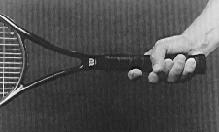

Front
|
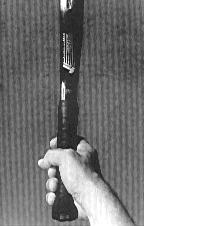

Top
|


Back
|
The eastern forehand grip is best suited to hitting flat drives. The next set of
illustrations show the semi-western grip:
Semi-Western Forehand
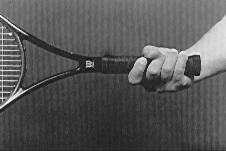

Front
|


Top
|
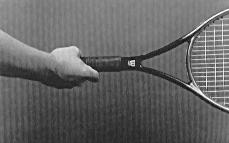

Back
|
The semi-western grip is more "closed" than the eastern grip. It's therefore ideal for hitting
topspin drives which require a steeper low-to-high swing. A more extreme version of this
grip, with the hand right underneath, encourages really heavy topspin and is used on court
surfaces where the ball bounces high.
The next set of illustrations show the conventional eastern one-handed backhand grip:
Eastern Backhand


Front
|
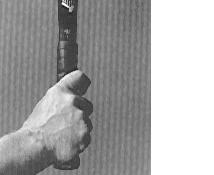

Top
|
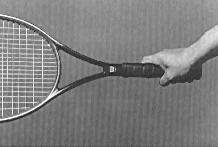

Back
|
There are two alternative grips for players who use both hands on the backhand. One involves
a bigger grip change (from the forehand grip) than the other:
Two-handed Backhand
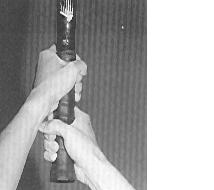

Small grip change
|
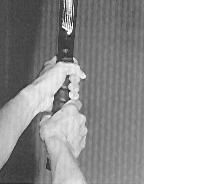

Big grip change
|
If you're unsure about your grip and the angle of your racket face (or you want to
experiment with a different grip), try rallying with a partner - with both of you at the service
line. Play groundstrokes (not volleys), but reduce your backswing and follow through so that the
rally stays under control. Once you're comfortable with it, move back a step at a time and
gradually increase the length of your swing.
  Back to the questions Back to the questions
|

|

|
It's what your other arm's for!
Question:
I hit a lot of shots off-balance. How can I improve this?
Answer:
The likeliest problem is inefficient footwork, but we've addressed that elsewhere, so let's
consider some other methods for maintaining good balance in tennis.
Try to "plant" yourself at least temporarily when you play your shots and use your legs
by sinking a little at the knees then straightening them again through the shot. Practise
synchronising this with your hip and shoulder rotation.
What would you do if you had to walk along a log across a ravine? Well, naturally you'd
stick out both arms for balance. And it's therefore no coincidence that using both
arms is one of the keys to good technique in tennis. It's not just your racket arm that
controls the shot.
As you take your racket back for a forehand groundstroke, extend your other arm towards the ball.
Your balance will improve immediately and you'll be able to transfer your weight into the shot.
Similarly, when you play an overhead, keep your balance by pointing to the ball with your free
hand.
If you use a single-handed backhand, keep your non-racket hand on the throat of the racket and
don't let go until you're ready to swing forwards - then keep your free hand outstretched behind
you for balance.
If you can't think of all this in the hurly-burly of a match, go for the quick fix - KEEP YOUR
HEAD STILL!
  Back to the questions Back to the questions
|

|

|
Hitting bigger without hitting bigger!
Question:
How can I get more power without radically changing my technique?
Answer:
You can achieve more power on your groundstrokes by transferring your weight forwards, by
swinging faster and by hitting more through the ball. These are things you can apply
without too much tinkering with your technique.
The power drives of the modern game, however, are produced by adopting an open stance and
driving up from the legs and rotating the upper body (hips, trunk and shoulders) and if you're
not already doing that, the change is fairly drastic and you probably need to book some
lessons.
But let's try thinking laterally for a minute. Your basic technique is sound and you don't
want to bin it, but you do want to inflict more damage on your opponent. Ok, so why not try
this - take the ball earlier! Instead of waiting for the ball to drop, step in and take it at
the top of the bounce. Once you're comfortable with this (and it'll take a while, so be
patient!), try taking it on the rise.
You'll have more angles at your disposal and your opponents will have less time to prepare
for their shots. It's kind of hitting bigger without hitting bigger! Cool, eh?
  Back to the questions Back to the questions
|

|

|
Shoot the bullseye!
Question:
How do you hit down the line?
Answer:
You can determine the direction of your shots by making contact with the ball more in front of
you (for crosscourt shots) or further back (for down the line shots), but I don't recommend it!
For the sake of comfort and consistency, you should make contact just in front of your body on
all your groundstrokes.
What I do recommend is that you follow through toward your target, perhaps extending out a
little longer on down-the-line shots and pulling across a fraction earlier on crosscourt shots.
The difference is actually minimal and if you simply think of driving the strings towards
your target, that should do it.
If it doesn't, try hitting slightly towards the outside of the ball for crosscourt shots
and right on the bullseye for down the line shots.
Oh, and by the way, if the ball comes to you crosscourt and you want to go down the line,
make sure you adjust for the angle off your racket!
  Back to the questions Back to the questions
|

|

|
On the up and up!
Question:
How do you hit groundstrokes on the rise?
Answer:
There's plenty of good reasons to hit on the rise. What are they? Well, you can hit with
more power because your opponent's pace is still on the ball. Also, you give your opponent
less time to recover and therefore less time to prepare for the next shot. And the more
you move inside the baseline the more you see over the net, enabling you to open up the
rally with angled shots. If you like getting into the net, hitting on the rise gives you a
better chance of closing in.
So, how do we do it? For one thing, you need to get inside the court during the rallies!
Easier said than done - it's a psychological leap because you're leaving that familiar comfort
zone behind the baseline - so try it in practice first! The other thing that will take some
adjustment is your backswing. There will be less time for it, so you need to make it as
efficient as possible - a good shoulder turn will probably suffice. Relax at the knees and
stay light on your feet. Start your swing early enough to ensure firm contact just out in
front of your body. Although you've had to adopt a more compact backswing, accelerate the
racket head and follow through smooth and long and full.
One thing you've got to consider is the angle of the ball as it comes on to your racket -
instead of a flat or downward trajectory, the ball will be angling upwards onto your strings.
You'll find you won't keep the ball in the court if you use an open racket face. So adjust your
grip to close the racket face slightly. It's probably a good idea to brush up on the ball to
impart some topspin. This will give you a greater degree of control.
  Back to the questions Back to the questions
|

|

|
The Ten Commandments!
Question:
How do you hit drop shots?
Answer:
| 1. |
Thou shalt use the drop shot when thy opponent is way behind the baseline (or retreating
away from thy target zone). |
2. |
Thou shalt draw a baseliner in to the net - away from his or her comfort zone. |
3. |
Thou shalt tire thy opponent by using the drop shot and following it with a lob. |
4. |
Thou shalt apply some backspin, causing the ball to dip sharply into thy opponent's
court and then "die" after it bounces. |
5. |
Thou shalt use the same grip as for thy normal groundstroke (but players using extreme
closed grips should change to an Eastern or Continental grip). |
6. |
Thou shalt produce the backspin by using a high-to-low swing (if thou use a high backswing
on thy normal groundstrokes, thou shalt develop the art of disguise by preparing thy racket
just as thou wouldst for thy normal shot). |
7. |
Thou shalt bring the racket smoothly forwards and downwards, slowing down the swing just
before contact, turning thy forearm to open the racket face. |
8. |
Thou shalt strike the ball at the same height as thou wouldst for thy normal groundstrokes -
don't let the ball drop too low. |
9. |
After contact, thou shalt continue moving your racket towards thy target area with a smooth
and natural follow-through. |
10. |
Thou shalt play the drop shot as an alternative to the approach shot, i.e. when thou art
between the baseline and service line, thereby deceiving thy opponent, causing him to
blaspheme more outrageously than I have in this article! |
  Back to the questions Back to the questions
|

|

|
Strike three!
Question:
What height should the ball be when I hit my groundstrokes?
Answer:
When you're hitting groundstrokes, you'll find it easier to control
the ball if your contact is somewhere between mid-chest and knee,
a comfortable arm's length away from you and just slightly in front
of your body. This is your ideal strike zone.
When your opponent hits the ball, it arrives with gradually diminishing
speed. It rises after the bounce and then levels off for a moment
as its speed dies.
If you can adjust your footwork so that the levelling-off moment occurs
in the middle of your ideal strike zone, you've cracked it! Tennis is
a breeze!
But it isn't always that easy. Although most balls level off somewhere
between shoulder-height and knee-height, sometimes the ball bounces too
low or too high. You may have to hurry forwards to short balls and you
may have to bend your knees to cope with low balls. High-bouncing balls
travel through your strike zone twice - once on the way up and again on
the way down, so you have the luxury of a choice.
The face of your racket must be square to the ball at contact. Swing it
up through the strike zone from below the level of the ball, finishing
above it.
A common mistake is getting in line with the ball, with the result that
you get jammed by it. It's okay to position yourself on the tracks, but
remember to dodge aside before the train arrives!
The strike zone is important in baseball, too. Rules committees frequently
argue over its definition. When the umpires "shrink" the strike zone, there
are more home runs and the hitters (and the fans) are happy. But when
they allow a larger strike zone, it favours the pitchers and the home runs
start to dry up.
Let's apply a baseball analogy to tennis. Let's say you're hitting
balls at all different heights, one ball up around your armpits and
the next down below your knees. Well, clearly this is the equivalent
of a baseball umpire allowing a large strike zone. And your opponent -
the pitcher - is just grinning all over his face.
Use anticipation and footwork to shrink that zone and start scoring!
  Back to the questions Back to the questions
|

|

|
Good timing is just one puff away!
Question:
Is it really possible to watch the ball right onto the racket?
Answer:
I'm not sure it's actually possible to see the ball when you strike it. Everything's just a blur
of hand and ball and racket. No matter how hard you stare at it, you can't see it distinctly.
It's less like a ball and more like a dandelion gone to seed.
Nevertheless, it's still good advice to watch the ball right through contact, because it
helps keep your head still, which in turn keeps you balanced.
In colloquial English, the sphere of dandelion seeds is referred to as a clock and, according
to folklore, you can use it to tell the time by counting how many puffs it takes to blow all
the seeds away.
Next time you're on the practice court, try blowing at the "dandelion clock"! It'll help
your timing (pun intended!). You'll produce a balanced shot by keeping your head steady. And
it's a good idea to exhale as you hit the ball anyway!
  Back to the questions Back to the questions
|

|

|
Take a new approach to an old problem!
Question:
What's the best type of approach shot?
Answer:
Your effectiveness as a volleyer very much depends on the quality of the shot that gets
you to the net - the approach shot.
A major aspect of this is selecting the right ball to come in on. Look for a shortish ball
that lands in one of the service boxes. In fact, one of the best opportunities is a weak
service.
The next thing to consider is where to aim your shot. Approach shots should be mostly
down-the-line. If you go across court, you open up a lot of court for your opponent to pass
you. Most importantly, you leave yourself vulnerable to the down-the-line pass that you
have no time to cover. So, most of the time, go down-the-line and follow the ball in. But this
is not a hard and fast rule. There are times when a cross-court approach is preferable. If your
opponent is out of position, for example, it might be better to attack the space. It's also a
good idea to consider attacking an opponent's weaker side.
What about the type of shot? Well, using slice is often favoured because it's easier to play
on the move. Your weight transfers into the shot and it's easier to stay balanced as you
follow through and move in. Slice also keeps the ball low, forcing your opponent to lift the
ball, giving you a good chance of volleying at a comfortable height.
Topspin allows you the insurance of net clearance and dip and it may present your opponent with
an awkward ball that kicks up and forwards. The important thing is to keep a topspin approach
deep. If you present your opponent with a short, high-bouncing ball, you could find yourself
in a whole lot of trouble.
If you find you have to wait too long for short balls, consider using a "moonball" approach.
Hit the ball high and deep with topspin so that your opponent is forced to deal with it from way
back behind the baseline. Sometimes your opponent will be surprised to find you at the net and
you'll get a relatively comfortable volley, but if he or she sees you coming you'd better
expect the lob to go up!
So - back to the question - what's the best type of approach shot? Well, if you weigh up
all the factors I've mentioned above, you should have quite a few attacking options to work on.
At the end of the day, the best type of approach shot is the one you execute best and the one
that hurts your opponent most!
  Back to the questions Back to the questions
|

|

|
|






















